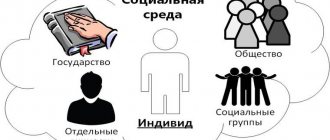Hello, dear readers of the KtoNaNovenkogo.ru blog. Children show their negativism towards toys and parents.
Teenagers are often aggressive and violate the norms and rules of behavior in society. And adults take it out on their family members after prolonged stress (what is this?) at work.
Is destructive a character, or a common reaction to external stimuli? What is the reason for this behavior, and what to do about it?
Destructive behavior is...
Destructive behavior is physical actions or words aimed at destroying something: relationships, objects, health, mood, peace, tranquility.
A person invades someone else's life and ruins his own. Can overstep norms (what is this?) and laws.
Expressed as:
- stubbornness;
- aggression;
- coarseness;
- fear;
- intolerance;
- pugnacity;
- hatred;
- panic.
Unconscious goals can be bullying, torture, or even killing living beings: both animals and people. Also a violation of social peace - coups in the state and acts of terrorism (what is that?), harm to nature or property.
Types of destructive behavior:
- Narcissistic . The self-esteem of such people is greatly inflated. A raised bar of one’s own value does not allow one to adequately build relationships with others. There is a lack of critical thinking, which does not allow one to adequately account for one’s actions.
- Addictive . They may depend on harmful substances - alcohol, drugs, cigarettes, as well as on slot machines or computer applications.
- Fanatical . They are passionate about something with a very strong passion, which goes beyond the boundaries of an ordinary hobby (what is this?). Faster to addictive behavior.
- Antisocial. Behavior is aimed at worsening relationships between acquaintances; to violate moral standards, rules in a small social group and government laws.
- Suicidal . Destructive temperament directed at oneself. A person can cause damage to the skin with sharp objects. Or try to commit suicide.
- Autistic . Characterized by self-isolation and difficulty in building trusting relationships with people. As well as aggressiveness and negativism towards the entire world around us.
There are differences in destructive behavior depending on gender .
Men are prone to extreme sports and entertainment, and performing dangerous work. Women choose a passive form of self-destruction - they exhaust themselves with routine obligations.
What it is
The concept of destructiveness comes from the Latin term “destructio”, meaning disintegration, destruction of a structure.
Destructiveness is a personal property in psychology, characterized by a negative attitude of people towards their own personalities, as well as other people, and a corresponding destructive behavioral pattern.
A destructive behavioral pattern is a verbal or practical manifestation of the internal life activity of subjects, aimed at destroying something. Such a behavioral reaction sometimes results from a defensive tool consisting of identifying oneself with the attacking party, which can be used against an internal or external force. The subject (individual) often chooses the communicative interaction between subjects, their relationships, their own emotional and physical state, and elements of the material world as objects of deviant behavior. The subject introduces danger into his own mental world and tries to defend himself from it, as a result of which identification with the hostile environment is observed. In order to convince oneself of such identification, a person acts destructively. In addition, destructiveness can be caused by following rituals.
Well-known practitioners of psychoanalysis S. Freud and E. Fromm followed different theoretical views regarding the genesis of destructiveness. Freud argued that personality destructiveness is inherent in all subjects and varies in direction. For his part, Erich Fromm believed that human destructiveness occurs sometimes. If it appears, it is directed at the internal environment of a person and only then at the external world as a projection.
According to Fromm, destructiveness is revealed by a conscious desire to destroy and rise above others. He argued that what distinguishes homo sapiens from animals is his ability to commit murder. It can become destructive regardless of the presence of a danger to self-preservation, and human deviance is not caused by the need to satisfy needs.
Thus, destructiveness is, in simple words, a kind of destructive, hostile behavior of individuals, directed either at external objects or at themselves. It lies in the inability to rationally respond behaviorally and the inability to create the basis for further productive activity.
Destructiveness is a supporter of quick results. People with the described property refuse to understand that success must be long-term; they are focused only on immediate results. Getting a quick result is considered a destructive idea.
A destructive pattern of behavior is largely identified with deviant behavior and implies psycho-emotional disruptions in the behavioral model of individuals, characterized by external hostility, revealed in the desire for destruction.
History of the study of destructiveness
In S. Freud's of the forces that drive each personality, the death instinct occupies a significant place.
It means that a person strives for a primary inanimate state through destructive behavior.
K. Lorenz , like Freud, believes that aggression is inherent in the instinctive mechanism. It promotes adaptation (what is it?), adaptation to various conditions. As well as survival among other individuals, taking their position in the social hierarchy.
A. Bass gives the definition:
“Aggression is a reaction that brings pain to the organism at which it is specifically directed.”
This is one type of behavior to achieve a goal. Often the meaning of aggression is to force another person to do something - a type of manipulation (what is this?).
F. Allan believes that this is simply a way to gather one’s strength in order to withstand external factors. L. Bender says that people use destructiveness to get closer or further away from a person or situation.
Other points of view on destructive behavior:
- natural human reflex;
- reaction to mental or physical discomfort;
- drive and passion, which brings pleasure, despite all the negativity;
- the result is frustration (what is it?) – when it is impossible to satisfy one’s needs or solve a problem.
How to use wild rose for healing?
People use all parts of the wild rose for treatment. Official medicine only recognizes fruits. What diseases does the plant help with?
1.
The flowers are used
to make teas
that relieve:
- cardiovascular diseases;
- diarrhea;
- excess cholesterol and plaques inside blood vessels.
2.
Wild rose roots
in the form of an infusion
help with:
- hemorrhoids;
- allergies;
- inflammation of the kidneys and bladder.
3.
The most common part of the plant in pharmacology is
the ripe fruit
. They are used as:
- a choleretic agent (probably everyone has tried Kholosas
- a sweet, tasty remedy that is a syrup made from rose hips); - general strengthening and immunity enhancing medicine;
- a drug for atherosclerosis and senile dementia by strengthening blood vessels;
- a drug that has a positive effect on metabolism and promotes weight loss.
And the flashing statements about the “uselessness” of dog rose hips are just another “duck”. This species is also suitable for medicinal purposes. That is why the fruits of the plant are so widely used to treat colds.
.
However, during heat treatment (boiling, pouring boiling water), the lion's share of this vitamin dies. But it passes into alcohol-containing tinctures in full, without being destroyed. Accordingly, the most suitable processing method for preserving vitamin C is fruit tincture.
Destructiveness in childhood
Psychologist Alfred Adler was the first to study destructive behavior in children and classify possible motives .
Power struggle
Every child strives to show his strength and try to pull the veil of power over himself.
Some do this passively , and after mom’s words: “Do your homework” or “Wash the dishes,” they simply do not follow these instructions. Others immediately aggressively show their position: “I don’t want to, I won’t.”
In such a situation, parents should explain what the consequences of non-compliance and disobedience will be. Let your son or daughter take responsibility (what is that?) for their actions and decide what to do.
To attract attention
If a child constantly pulls at his parents at home, on the street, and in the store, and also annoys teachers by frequently leaving the classroom during class or talking loudly, then these are all ways to attract attention. It's obvious that he's missing.
Parents should devote more time to their children. Not only when you need to criticize them, but also in a positive way. And if the child whines: “Pay attention! Play now!”, then you should say: “Okay, in 10-15 minutes, when I’m free.”, and not run away immediately, so that this does not become a mechanism for manipulation.
Revenge
If children don’t like the way they are treated , they will take revenge in a variety of ways: calling people names, lying, stealing, painting the walls or their mother’s favorite book, or even hitting.
In such situations, it is better to consult a psychotherapist. Most likely, the parents cannot establish a trusting relationship, and they themselves show initial anger. Therefore, we need a specialist and an outside perspective.
Demonstration of insolvency
The child does not believe in the success of completing tasks and instructions. Therefore, he skips school and tutors, does not want to go to the blackboard and starts a scandal on this basis, lies.
Most likely, the reason is constant criticism and an authoritarian method of education, which needs to be changed immediately. Such children need to be supported in all their endeavors, praised and given attention when spending time together.
How to make business relationships constructive
By applying certain rules and methods of business communication, team members will interact as a single organism. A clash of opinions and such a destructive conflict will become a thing of the past - this is the “tank” method, a method of war that brings destruction to minds, families and businesses. To peacefully find a productive solution, both parties must act as follows:
discuss only this problem, and not individual personality traits; remember that partners are not each other’s enemies; restrain yourself from manifestations of anger, unbridled anger, desire for revenge or punishment; forceful methods of struggle can only do harm; when defending your own point of view, it is important to take into account the interests of your opponent; interaction should be friendly and open; opponents need to tune in to understanding and interaction.
By strictly observing these rules and adhering to the framework of business communication, you can always find a way out of the situation. If one of the participants in the confrontation commits a gross violation, the entire process may get out of control and turn destructive. This will not benefit either side, and the contradictions may only intensify.
Destructive teenager
In adolescence, those who are more likely to engage in destructive behavior are those who:
- increased anxiety;
- fixation on negative aspects;
- depressive disorder;
- increased feeling of guilt for the problems of loved ones;
- somatic or mental illness.
Possible reasons:
- Conflicts with friends and classmates. They may be due to the fact that the child does not keep up with others in development, or the teacher openly dislikes him. Or the teenager is very quiet and shy, differs in his worldview (what is this?). Because of this, self-esteem and the ability to withstand stress decreases.
- Family problems . Not all parents can maintain warm and sincere relationships with each other. Therefore, they often resort to divorce, rude communication among themselves, and long silences.
- Unhappy love. In adolescence, people fall in love very much and dive headlong into this new feeling. Therefore, if someone breaks their heart, they take it very dramatically. And after that they direct aggression towards themselves or other people.
- Fear of loneliness . It is important for children to be part of a small social group. Therefore, if you fail to be recognized in a certain social circle, this can cause destructive behavior.
- Imitation of idols . Celebrities often behave rudely and condescendingly towards others. Children see them breaking instruments on stage and throwing a TV out of a hotel window. Teenagers do not have developed critical thinking, and they want to be like them.
In such situations, it is worthwhile to instill in children a positive outlook on the world and involve them in useful activities.
Parents must also establish trusting contact so that maturing individuals can trust them, ask for help and know that they will be heard.
Causes
It is customary to divide behavioral patterns into destructive or abnormal behavior and constructive (normal), generally accepted behavior. An abnormal behavioral response, from which a destructive one is formed, is characterized by non-standardity, bordering on pathology, and disapproval by society. It is often a deviation from the position of social guidelines, medical norms, and psychological attitudes.
Every behavioral model is established in childhood. A four- to five-year-old baby assimilates information that determines his future relationships with the social environment
A full-fledged family in which mutual understanding reigns, care, attention, and love prevail has a beneficial effect on the maturation of the psyche of children and lays the foundations for behavioral patterns. Hence, individuals who have not received adequate education, warmth, attention, love belong to the risk category
You should also be aware that children often borrow the destructive behavior patterns of their own parents.
Scientists have found that destructive personality behavior is successfully formed against the background of the presence of such factors:
– the presence of numerous social deviations (bureaucracy, corruption, alcoholism, crime);
– liberalization of measures of social influence (lowering the level of censure and criticism);
– situational anomalies (speculations, fictitious marriages);
– relaxation of measures to combat abnormal behavior (absence of fines, punishment system).
Freud was convinced that destructive behavior is the result of an individual's negative attitude towards himself. He also argued that destruction represents one of the basic drives. Proponents of psychoanalytic theory argued that abnormal actions are inherent in all human subjects to varying degrees, only the objects of such actions differ (other personified or inanimate objects, or himself). Adler held a similar view, believing that the fundamental cause of destructive behavior is a feeling of alienation and failure.
Fromm argued that destructive behavior provokes a person’s unrealized potential, as well as the inability to use fruitful energy for its intended purpose. Durkheim carried out a social analysis of the considered variation in behavioral response, and the works of Merton, Worsley and other representatives of sociological science are devoted to the study of the causes, factors and types of deviant actions. For example, Merton wrote that destructive behavior is caused by anomie - a special moral and psychological state characterized by the collapse of the system of moral and ethical values and spiritual guidelines. Worsley, in turn, studied the relativity of the relationship between sociocultural norms and “absolute” standards.
Signs of a destructive person (destructor)
A person's destructive nature may not be corrected in childhood or adolescence, so he will carry it throughout his life. How do you know if this type of person is in front of you?
Hidden and obvious threats
It is important for destructive individuals to know that they are better than others, and the whole world owes them. To maintain this role and pride, he does not allow others to express their opinions. It also suppresses any disobedience and criticism. The interlocutor may hear a commanding tone or a threat.
Triangulation
A person involves third-party people in a dispute, whose opinions supposedly coincide with his, and not his opponent’s. He makes references to the fact that his colleagues, friends, scientists are also on his side. Thus, it puts pressure on the victim to break and accept the interlocutor’s position.
Bounds checking
Such people like to check where other people's boundaries are. And every time they try to break them, while they remain unpunished. Therefore, if the victim returned to the offender, then this gives the latter a reason to further exhaust her with his exploration of the framework.
Cruel sarcasm
Humiliating others is a favorite activity of narcissists (who is that?) with destructive personalities. Sarcasm (what is it?) helps a lot with this, since you can turn everything into an innocent joke in time. And if a person is offended, then it is his “problem” that he is so sensitive.
Gaslighting
If you hear, in response to your remark about the behavior of the character being discussed, the phrase: “That didn’t happen!”, “What happened to your memory?!”, “It seemed to you,” then know that this is manipulation. The interlocutor is trying to destroy confidence in reality and shake the conviction that he is right.
Thermal destruction
In principle, the splitting of compounds under the influence of heat should not differ from hydrocarbon cracking, the chain mechanism of which has been established with absolute certainty. In accordance with the chemical structure of polymers, their resistance to heat, the rate of decomposition, as well as the characteristics of the products formed in the process are determined. The first stage, however, will always be the formation of free radicals. An increase in the reaction chain accompanies the breaking of bonds and a decrease in molecular weight. Termination can occur through disproportionation or recombination of free radicals. In this case, a change in the fractional composition, the formation of spatial and branched structures may occur, and double bonds may also appear at the ends of macromolecules.
Forms
To begin with, it should be noted that there is a distinction between constructive and destructive behavior. The first is creative and is absolutely normal for any healthy person. The second often turns out to be a symptom of some mental disorder.
In psychology, destructive human behavior varies in direction and nature of manifestation. So, we have already talked about the first classification: a person can address his destructive energy to any object of external reality or to himself. It is interesting that manifestations of destructiveness are not always negative: it can be part or the beginning of creation. For example, you can demolish a dilapidated house to build a new one in its place, or cut your long hair to create a beautiful hairstyle.
Another classification of destructive behavior is based on the nature of the manifestation of destructiveness. There are two main forms:
- Delinquent – this includes actions that are contrary to legal norms, for example, violations of discipline, illegal violations.
- Deviant is behavior that contradicts moral standards, for example, drug addiction and alcoholism, attempts to commit suicide.
Notes
- Yaroshevsky M. G. History of psychology. - M., 1985.
- Afanasyev V. S., Gilinsky Ya. I. Deviant behavior and social control in the conditions of the crisis of Russian society. -SPb., 1995.
- Kulikov V. B., Zlokazov K. V. Destructive behavior: theoretical and methodological aspect // Psychopedagogy in law enforcement agencies / -2006
- Korolenko T. P., Dmitrieva N. V. Sociodynamic psychiatry. - Moscow-Ekaterinburg, 2000.
- Zlokazov K.V. Destructive behavior in various contexts of its manifestation // Bulletin of the Udmurt University. Series “Philosophy. Psychology. Pedagogy". — 2016











